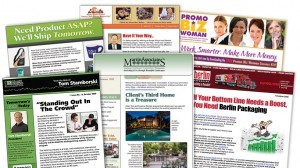How to Prepare an Email Marketing Content Plan
June 12, 2013
montage-of-email-samples-300x168.jpg

A content-rich email program features stories and graphics that are relevant to readers. Be sure your headlines also entice recipients to read your emails.
Cathy Cain-Blank of CC Marketing creates custom email communications for promotional products distributors and other small/midsize companies. She is a periodic contributor to the Maple Ridge Farms blog.
Several times a week we’re contacted by marketers from companies of all sizes and types who are at a standstill in their efforts to launch or improve an email marketing program. Their biggest challenge: content. They get the concept of sharing meaningful, relevant information with their customers and prospects, but they struggle with what kind of information to pass along.
If you’ve ever started and soon after pulled the plug on an email program, or you’ve avoided this marketing tool altogether, the suggestions below should help you move forward.
Set Your Frequency. Monthly is the norm for B2B email communications. If you can’t budget the time/resources to develop a monthly email, opt for bimonthly and consider “bonus” emails when you have important news to share. Your audience will wonder what’s up if you announce plans for a monthly email only to send two consecutive mailings followed by nothing at all. To help you stay on track, create a detailed production schedule mapping out the dates all tasks are due – from writing copy to setting up the email campaign.
Brainstorm Regularly. You’ll want to integrate timely news with other content. Have a monthly planning session – even if the meeting consists of you, your notepad and pen. A few new ideas generated each month will enable you to perpetually extend your editorial calendar.
Prepare Customer-Centered Content. One trap many companies fall into is focusing on what they want to tell their audience as opposed to what their audience is interested in reading. As a starting point, jot a list of the questions you are regularly asked by customers and prospects. Whether they relate to artwork, decorating techniques, special offers, new products, or what’s hot, the answers will give you topics to consider.
Other ideas to add to your plan: promotional strategies for different occasions and opportunities (even if some don’t apply to your audience buyers will appreciate learning what others are doing), new projects (share details buyers would find helpful to know, such as how quickly you solved a problem or a novel approach to an old problem), volunteer activities, industry trends, and buying guidelines (e.g., how much is needed for a food gift serving 10 people).
Your plan should include creating a few custom graphics for your templates. A few examples: a header featuring a montage of products alongside your logo, a banner ad enticing buyers to click through to your website, and artwork reflecting a milestone (e.g., celebrating 10 years) or industry award. While words can relay these messages, professional-looking graphics will break up the text.
Vary the Format. Newsletters are mainstays for many companies but other types of emails are effective, too. Let’s say you frequently explain decorating options to new buyers. Prepare a PDF featuring a glossary of methods and distribute it using a “Helpful Tips” email template. You’ve then presented information in a format designed to be kept, as opposed to a newsletter article.
Another idea is to create a Welcome/Introductory email for new contacts. Acknowledge your relationship and include links to important website pages or brochures. Throw in a special offer, a short success story, and key contact information, and you’ve officially said hello with some splash. Emails linking to videos are also typically well received.
If you need content about food gift programs, be sure to ask Maple Ridge Farms for help. They have a lot of material, from tips, sales sheets and videos, designed to entice buyers to take the next step.

